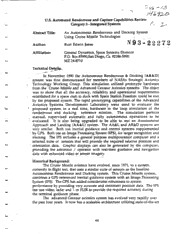
NASA Technical Reports Server (NTRS) 19930013083: An autonomous rendezvous and docking system using cruise missile technologies PDF
Preview NASA Technical Reports Server (NTRS) 19930013083: An autonomous rendezvous and docking system using cruise missile technologies
U.S. Automated Rendezvous and Capixtte Capabilities Review Category 3 - Integrated Systems P.. j_ Abstract Title: An Autonomous Rendezvous and Docking System Using Cruise Missile Technologies - v -- Author: Ruel Edwin Jones N 9 3 " 2 2 2 7 Affiliation: General Dynamics, Space Systems Division P.O. Box 85990,San Diego, Ca. 92186-5990 MZ 24-8710 Technical Detafl__ In November 1990 the Autonomous Rendezvous & Docking (AR&D) system was first demonstrated for members of NASAs Strategic Avionics Technology Working Group. This simulation utilized prototype hardware from the Cruise Missile and Advanced Centaur Avionics systems. The object was to show that all the accuracy, reliability and operational requirements established for a space craft to dock with Space Station Freedom could be met by the proposed system. The rapid prototyping capabilities of the Advanced Avionics Systems Development Laboratory were used to evaluate the proposed system in a real time, hardware in the loop simulation of the rendezvous and docking reference mission. The simulation permits manual, supervised automatic and fully autonomous operations to be i evaluated. It is also being upgraded to be able to test an Autonomous Approach and Landing (AA&L) system. The AA&L and AR&D systems are very similar. Both use inertial guidance and control systems supplemented w by GPS. Both use an Image Processing System (IPS), for target recognition and tracking. The IPS includes a general purpose multiprocessor computer and a selected suite of sensors that will provide the required relative position and orientation data. Graphic displays can also be generated by the computer, providing the astronaut / operator with real-time guidance and navigation data with enhanced video or sensor imagery. Historical Background: The Cruise Missile avionics have evolved, since 1971, to a system, currently in flight test, that uses a similar suite of sensors as the baseline Autonomous Rendezvous and Docking system. This Cruise Missile system, combines a GPS referenced inertial guidance system with an Image Processing System (IPS). The GPS has added considerable robustness to system performance by providing very accurate and consistent position data. The 1PS can use video, ladar and \ or FLIR to provide the required accuracy during the terminal guidance phase. The advanced Centaur avionics system has evolved very rapidly over the past four years. It now has a scaleable architecture utilizing state-of-the-art 46 _..._- m strap-down inertial sensors and processor technology. The baseline AR&D i system uses a Triple _dular Redundant configuration to meet the projected reliability requirements for an Expendable Launch Vehicle servicing Space Station Freedom.. g Technology Maturity: II The Centaur and Cruise Missile avionic systems have been evolving for twenty years. Integration of GPS into both systems has been underway for over five years with a_olIo,_-on cruise missile sys--_m currently in flight test. Rendezvous and Docking related studies have been conducted for over five years in support of the Advanced Upper Stage, OMV and other IR&Ds.The system and AR&D simulator z demonstrated to the SATWG has been upgraded considerably under two iR&D mm programs in 1991. New acquisition and tracking algorithms have added the necessary robustness to the image processor control loop so ciijferent sensors and interfacing filters to the autopilot can be evaluated. New interactive summary i displays were added to allow real time monitoring and post test system performance analysis. Test Experience: _e Centaur and Cruise Missile avionics systems havebeen tested and I operationally validated for over twenty years. The combined AR&D system has been under development and testing for a year. A Joint NASA / GD ARD&L System Te_st Program is currenflyT_/e]i_g planned to validate several aspects of system I performance in three different NASA test facilities in 1992. | Sponsorship and Fundmg":_..... " ................................ _ _' _' ' Currently, the development of the integrated rendezvous and docking system is being pursued on IR&D funding. General Dynamics is working with Johnson Space Center, Marshall Space Flight Center, and Langley Research Cer_ter in a l cooperative test and demonstration effort. This multi-center program combines the expertise and testing capabilities to establish and validate a performance baseline for autonomous rendezvous, docking and landing systems. g Biography." _ II Edwin Jones received the B.S. and M.S. degrees from Brigham Young University in 1965 and 1969 in Physics and Psychology,(Human Engineering)..Mr. Jones has worked on aerospace programs for over thirty years. His assignments have ranged from teaching GAM 77 air launched cruise missile systems to system design, payload integration and launch site integration at Vandenberg AFB on the Space Shuttle Program. During the Apollo Soyuz program, he taught the Docking i system to NASA astronauts, flight controllers, and Soviet Cosmonauts. Eds current assignment is principle investigator on the joint General Dynamics / NASA Autonomous Rendezvous, Docking and Landing System Test Program. I I 48-1 u
